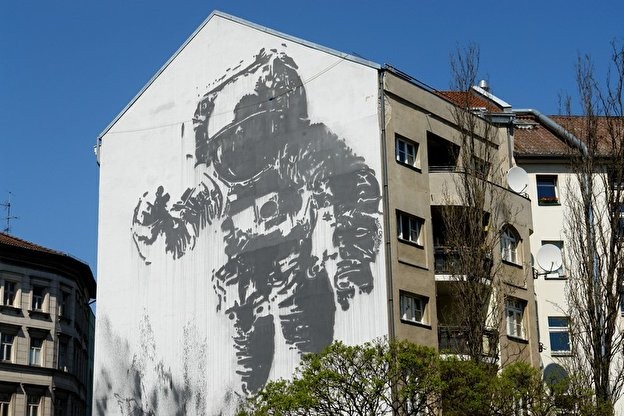Victor Ash's Astronaut Cosmonaut
Introduction
Text-to-speech Audio
In 2007 Victor Ash created one of Berlin's most iconic murals, the Astronaut Cosmonaut. The mural is on a white building located in Kreuzberg, Berlin and features an astronaut floating in space. Though simple in appearance, the mural comments on multiple culturally important aspects of Berlin and has become one the city's most pictured murals, making it an important part of Berlin's cityscape.
Images


Backstory and Context
Text-to-speech Audio
In 2007 Victor Ash created one of Berlin's most iconic murals, the Astronaut Cosmonaut. Located on the side of a white building in Kreuzberg, Berlin, the mural features an astronaut floating off into space. The mural is significant to Berlin's history for multiple reasons, one of them being the significance of the space race between the Soviet Union and the United States. On August 26, 1978 Sigmund Jähn travelled to space as a part of the Soviet Union's Intercosmos program and became the first German, and the first East German, to go to space. As a part of this achievement Sigmund Jähn was named a hero of the Soviet Union and received the award of the Order of Lenin, the Soviet Union's highest civilian honor. Not only was Sigmund Jähn a hero to the Soviet Union, he was also a hero to East Germany as East Germans believed that his journey to space showed their superiority to West Germany. The mural pays homage to the cultural icon that Sigmund Jähn became.
The mural also represents the desire to escape reality, a desire that Germans, and particularly Berliners, are most likely very familiar with has a result of their tumultuous history including World War I, the Holocaust, and the Berlin Wall. The idea of an astronaut representing this feeling was introduced by David Bowie, who is beloved by Berlin thanks to his Berlin Trilogy. Bowie's song "Space Oddity" tells the story of an astronaut getting lost in space. The Astronaut Cosmonaut mural embodies this by showing the actual depiction of an astronaut floating through space. In Bowie's song "Ashes to Ashes" it is discovered that this astronaut is not an astronaut at all, but rather a junkie using drugs to escape reality. This idea of using drugs as an escape is something the city of Berlin is very familiar with, especially during the 1960s and 70s during the process of reunification when much of Berlin's youth partook in the drug scene to escape from their chasing realities.
Sources
“‘Astronaut Cosmonaut’ by Victor Ash.” Goethe, Goethe Institut, https://www.goethe.de/ins/us/en/kul/art/abi/ash.html.
The Editors of Encyclopaedia Britannica. “Sigmund Jähn.” Encyclopædia Britannica, Encyclopædia Britannica, Inc., 17 Sept. 2021, https://www.britannica.com/biography/Sigmund-Jahn.
https://www.berlin.de/kultur-und-tickets/tipps/kunst/streetart/4379885-4376139-victor-ash-astronaut-cosmonaut.html
